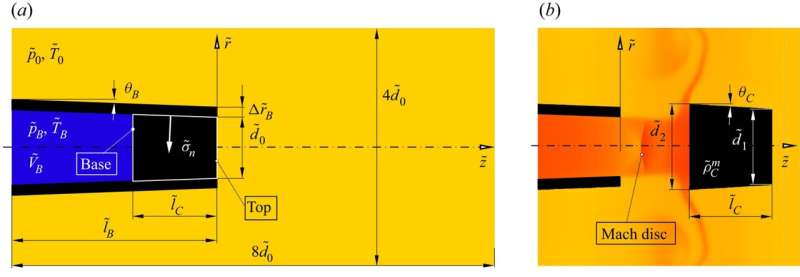This article has been reviewed according to Science X's editorial process and policies. Editors have highlighted the following attributes while ensuring the content's credibility:
fact-checked
trusted source
proofread
Popping a champagne cork reveals propulsive dynamics

Researchers have resolved the complex gas dynamics that occur upon opening a champagne bottle (or, more generally, a bottle containing a pressurized liquid and gas) and these dynamics' interaction with the bottle's cork stopper. The researchers' findings have been published in the journal Flow.
The team found that the difference between the pressure force at the cork's base and the (sliding) friction force decisively controls the cork's motion, as the pressure forces acting on its remaining surfaces have negligible impact. Since the (sliding) friction force decreases slower over time than the pressure force, the stopper's acceleration must exhibit a minimum, found to be near 0.5ms prior to its full escape. Moreover, this minimum value can become so negative that the stopper gets stuck inside the bottleneck.
The researchers adopted different strategies to assess the spatial and temporal consistency of the numerical method with respect to refined grid resolutions and maximum time steps.
They also notably identified that a Mach disk forms between the bottle opening and the freely moving stopper. Mach disks, also known as shock diamonds are the pattern of evenly spaced rings sometimes visible in the exhaust of an engine or other instances of propulsion.
The researchers found that the Mach disk in this instance initially exhibits a convex shape due to the radially varying times of the shock generation. The Mach disk reaches a maximum distance from the bottle opening and then retracts towards the opening. Furthermore, during this phase a second disk is potentially created upstream of, or split off from, the first.
These findings suggest that sensing the position of the Mach disk provides, quite remarkably, an option to determine either the gas pressure or temperature inside a champagne bottle.
First author Lukas Wagner, of TU Wien, noted that the study has applications well beyond understanding the physical forces involved in uncorking a champagne bottle.
"Our study can serve as a benchmark test for future experimental and numerical efforts, in particular regarding the spatial/temporal resolution of the full fluid–structure interaction of a high-speed gas flow with a solid moving obstacle," said Wagner.
"The current focus on the involved gas dynamics, highly unsteady and supersonic albeit at relatively moderate Mach numbers, might already provide a better insight into the complex details, specifically the shock structures, of transitional ballistics in related but more extreme situations of engineering importance."
More information: Lukas Wagner et al, Simulating the opening of a champagne bottle, Flow (2024). DOI: 10.1017/flo.2023.34


















